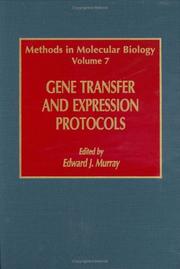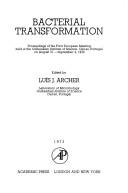| Listing 1 - 10 of 26 | << page >> |
Sort by
|
Book
ISBN: 1608052370 9781608052370 9781608054329 Year: 2012 Publisher: [Oak Park, Ill.] : Bentham eBooks,
Abstract | Keywords | Export | Availability | Bookmark
 Loading...
Loading...Choose an application
- Reference Manager
- EndNote
- RefWorks (Direct export to RefWorks)
Sperm-mediated gene transfer (SMGT) represents a novel set of technologies for animal (or in the future, human) genetic modification using the sperm as a vector, as opposed to more traditional established routes such as fertilized eggs or embryonic stem cells. This e-book brings together theoretical and empirical reviews from experts in SMGT, providing comprehensive coverage of the major trends, developments and controversies in this novel field.
Genetic transformation. --- Gene transfer --- Transformation (Genetics) --- Genetic recombination --- Microbial genetics --- Nucleic acids --- Transfection
Book
ISBN: 1848168306 9781848168305 9781848168282 9781908977281 Year: 2014 Publisher: London
Abstract | Keywords | Export | Availability | Bookmark
 Loading...
Loading...Choose an application
- Reference Manager
- EndNote
- RefWorks (Direct export to RefWorks)
This unique advanced textbook provides a clear and comprehensive description of the field of gene delivery, gene therapy and genetic pharmacology, with descriptions of the main gene transfer vectors and a set of selected therapeutic applications, along with safety considerations. The use of gene transfer is exponentially growing in the scientific and medical communities for day-to-day cell biology experiments and swift development of revolutionary gene therapy strategies. In this advanced textbook, more than 25 leading scientists, world-renowned in their respective fields, come together to pro
Genetic transformation. --- Gene therapy. --- Therapy, Gene --- Genetic engineering --- Therapeutics --- Gene transfer --- Transformation (Genetics) --- Genetic recombination --- Microbial genetics --- Nucleic acids --- Transfection

ISBN: 9780511541544 9780521821575 9780521129619 9780511345234 0511345232 051134452X 9780511344527 0511541546 0521821576 0521821576 1281108561 9781281108562 9786611108564 6611108564 1139130471 9781139130479 0511344899 9780511344893 0511344139 9780511344138 110714566X 0521129613 Year: 2005 Publisher: Cambridge, UK New York Cambridge University Press
Abstract | Keywords | Export | Availability | Bookmark
 Loading...
Loading...Choose an application
- Reference Manager
- EndNote
- RefWorks (Direct export to RefWorks)
This book provides an in-depth analysis of the mechanisms and biological consequences of genome rearrangements in bacteria. Genome rearrangements are a result of the actions of discrete genetic elements such as conjugative transposons, plasmids, phage, and non-conjugative transposons. Bacteria also contain systems to mediate genetic rearrangements such as the general recombination pathway and specialized endogenous recombination mechanisms. The biological effects of these rearrangements are far-reaching and impact on bacterial virulence, antibiotic resistance and the ability of bacteria to avoid the attentions of the host immune system (e.g. antigenic variation). These rearrangements also provide the raw material on which natural selection can act. Each chapter examines the mechanisms involved in genome rearrangements and the direct biological consequences of these events. This book is written by leading research workers and is an invaluable resource for graduate students and researchers in this field.
Bacterial genetics. --- Genetic recombination. --- Bacterial transformation. --- Transformation, Bacterial --- Transformation (Genetics) --- Cell transformation --- Genetic recombination --- Genetic transformation --- Microbial genetics --- Recombination, Genetic --- Chromosomes --- Recombinant DNA --- Bacteria --- Bacteriology --- Genetics
Book
ISBN: 9780511541520 9780521862974 9780511409813 0511409818 0511409273 9780511409271 051154152X 0521862973 1107178215 1281716952 9786611716950 0511407912 0511407173 0511408706 9781107178212 9781281716958 6611716955 9780511407918 9780511407178 9780511408700 Year: 2008 Publisher: Cambridge New York Cambridge University Press
Abstract | Keywords | Export | Availability | Bookmark
 Loading...
Loading...Choose an application
- Reference Manager
- EndNote
- RefWorks (Direct export to RefWorks)
Horizontal gene transfer is a major driving force in the evolution of many bacterial pathogens. The development of high-throughput sequencing tools and more sophisticated genomic and proteomic techniques in recent years has resulted in a better understanding of this phenomenon. Written by leading experts in the field, this edited volume is aimed at graduate students and researchers and provides an overview of current knowledge relating to the evolution of microbial pathogenicity. This volume provides an overview of the mechanisms and biological consequences of the genome rearrangements resulting from horizontal gene transfer, in both prokaryotes and eukaryotes, as well as overviews of the key mobile genetic elements involved. Subsequent chapters focus on paradigms for the evolution of important bacterial pathogens, including Salmonella enterica, Streptococcus pneumoniae, and Staphylococcus aureus. The influence of socioeconomic parameters in the dissemination of transferable elements, such as antibiotic resistant genes in bacteria, is also discussed.
Genetic transformation. --- Bacterial diseases --- Molecular evolution. --- Biochemical evolution --- Chemical evolution --- Evolution --- Life --- Molecular biology --- Bacterial infections --- Communicable diseases --- Medical bacteriology --- Pathogenic bacteria --- Gene transfer --- Transformation (Genetics) --- Genetic recombination --- Microbial genetics --- Nucleic acids --- Transfection --- Pathogenesis. --- Origin
Book
ISBN: 0080420001 1322257027 1483287777 Year: 1992 Publisher: Oxford : Pergamon press,
Abstract | Keywords | Export | Availability | Bookmark
 Loading...
Loading...Choose an application
- Reference Manager
- EndNote
- RefWorks (Direct export to RefWorks)
Gene transfer --- Genetic transformation --- Genetische transformatie --- Génétique microbienne --- Microben--Erfelijkheid --- Microbial genetics --- Microbiële erfelijkheid --- Transformation (Genetics) --- Transformation génétique --- -Microbial genetics --- -575 --- Microorganisms --- Genetics --- Microbiology --- Genetic recombination --- Nucleic acids --- Transfection --- Research --- -Methodology --- General genetics. General cytogenetics. Immunogenetics. Evolution. Speciation. Phylogeny --- 575 General genetics. General cytogenetics. Immunogenetics. Evolution. Speciation. Phylogeny --- -Research
Book
ISBN: 9780199692606 0199692602 9780199692590 0199692599 Year: 2011 Publisher: Oxford ; New York : Oxford University Press,
Abstract | Keywords | Export | Availability | Bookmark
 Loading...
Loading...Choose an application
- Reference Manager
- EndNote
- RefWorks (Direct export to RefWorks)
Evolution (Biology) --- Genetic transformation. --- Evolution (Biologie) --- Transfert de gènes --- 575.8 --- Evolution. Origin of species. Phylogeny --- Evolution (Biology). --- 575.8 Evolution. Origin of species. Phylogeny --- Transfert de gènes --- Genetic transformation --- Gene transfer --- Transformation (Genetics) --- Genetic recombination --- Microbial genetics --- Nucleic acids --- Transfection --- Animal evolution --- Animals --- Biological evolution --- Darwinism --- Evolutionary biology --- Evolutionary science --- Origin of species --- Biology --- Evolution --- Biological fitness --- Homoplasy --- Natural selection --- Phylogeny

ISBN: 0896031780 0896032167 1592594948 9781489944030 9780896031784 9780896032163 Year: 1991 Volume: 7 Publisher: Clifton (N.J.): Humana press,
Abstract | Keywords | Export | Availability | Bookmark
 Loading...
Loading...Choose an application
- Reference Manager
- EndNote
- RefWorks (Direct export to RefWorks)
Biology is the study of living things. The classical approach might be described as holistic and descriptive, whereas the modern molecular approach aims to be investigative, reductionist, and mechanistic . Genes contain all the information for the structure of all living things ; thus, the understanding of how genes are regulated is an important step toward understanding the nature of living things. The study of gene regulation has been made more tractable by the design of simple experimental models in which a single gene can be isolated from the milieu of the organism. The new science of molecular biology has introduced techniques that permit the design of such experimental models. In essence, the genome of the organism is dissected in such a manner that specific genes may now be introduced into an appropriate cell line . Subsequent analysis of the proteins expressed from the genes under study results in the identification of the regulatory DNA sequences .
Gene expression --- Transfection --- Genetic transformation --- Technique --- SCIENCE --- Life Sciences / Genetics & Genomics --- Genetics --- Biology --- Health & Biological Sciences --- Technique. --- Genes --- Genetic regulation --- Nucleic acids --- Viral genetics --- Gene transfer --- Transformation (Genetics) --- Genetic recombination --- Microbial genetics --- Expression --- Human genetics. --- Human Genetics. --- Heredity, Human --- Human biology --- Physical anthropology --- Gene expression - Technique --- Transfection - Technique --- Genetic transformation - Technique

ISBN: 9780126801262 0126801266 9786611033682 1281033685 0080534120 9780080534121 Year: 2002 Publisher: San Diego : Academic Press,
Abstract | Keywords | Export | Availability | Bookmark
 Loading...
Loading...Choose an application
- Reference Manager
- EndNote
- RefWorks (Direct export to RefWorks)
The second edition of Horizontal Gene Transfer has been organized to provide a concise and up-to-date coverage of the most important discoveries in this fascinating field. Written by the most prominent gene transfer and genome analytical scientists, this book details experimental evidence for the phenomenon of horizontal gene transfer and discusses further evidence provided by the recent completion of genomic sequences from Archea, Bacteria, and Eucarya members. The relevance of horizontal gene transfer to plant and metazoan taxonomy, GM foods, antibiotic resistance, paleontology, and p
Gene Transfer Techniques. --- Evolution, Molecular. --- Transcription, Genetic. --- Transformation, Genetic. --- Transgenic organisms. --- Genetic transformation. --- Organismes génétiquement modifiés --- Transfert de gènes --- Genetic transformation --- Transgenic organisms --- Genetically engineered organisms --- Genetically modified organisms --- GEOs (Genetically engineered organisms) --- GMOs (Genetically modified organisms) --- Organisms --- Genetic engineering --- Gene transfer --- Transformation (Genetics) --- Genetic recombination --- Microbial genetics --- Nucleic acids --- Transfection

ISBN: 0120594501 Year: 1973 Publisher: London Academic press
Abstract | Keywords | Export | Availability | Bookmark
 Loading...
Loading...Choose an application
- Reference Manager
- EndNote
- RefWorks (Direct export to RefWorks)
Genetics, Microbial. --- Transformation, Genetic. --- Bacterial transformation --- -Transformation, Bacterial --- Transformation (Genetics) --- Cell transformation --- Genetic recombination --- Genetic transformation --- Microbial genetics --- Genetic Transformation --- Genetic Transformations --- Transformations, Genetic --- Crosses, Genetic --- Transduction, Genetic --- Transfection --- Microbial Genetics --- Genetic, Microbial --- Microbial Genetic --- Virus Physiological Phenomena --- Bacterial Physiological Phenomena --- Genome, Microbial --- Congresses --- Congresses. --- -Congresses --- Genetics, Microbial --- Transformation, Genetic --- Transformation, Bacterial
Book
ISBN: 1299276822 2842542371 9782842542375 9782842542375 2842541715 9782842541712 9782842541712 9781299276826 Year: 2012 Publisher: Paris : EDP Sciences,
Abstract | Keywords | Export | Availability | Bookmark
 Loading...
Loading...Choose an application
- Reference Manager
- EndNote
- RefWorks (Direct export to RefWorks)
This book provides a 2012 reference for state-of-the-art gene transfer technology and the different aspects of its clinical translation with a focus on European-based initiatives. As examples of successful outcomes, recent clinical trials are presented together with Ethical, Safety and Regulatory issues, which are discussed. The broad range of various technologies is covered whether addressing direct in vivo gene transfer like with AAV, Adeno or non-viral vectors or ex-vivo genetically engineered cells including induced pluripotent stem cells (iPS) with integrating vectors such as retrovirus, lentivirus or transposon-derived systems. The critical path to clinical implementation is covered in the second part describing currently available tools - such as molecular imaging, ex-vivo organ cultures and high-throughput technologies used for evaluation of criteria towards a go-or-no go decision to move to the clinic; in addition, utmost salient biosafety and immunotoxicology aspects are discussed. This book is ideal for postgraduates, undergraduates, scientists, clinicians, regulators and patients' advocacy groups looking for states-of-the-art information as well as emerging prospects - including gene targeting and homologous recombination - in gene transfer intended for clinical translation.
Genetic transformation. --- Gene transfer --- Transformation (Genetics) --- Genetic recombination --- Microbial genetics --- Nucleic acids --- Transfection --- Gene Transfer Techniques --- Gene Delivery Systems --- Gene Transfer Technique --- Transgenesis --- Delivery System, Gene --- Delivery Systems, Gene --- Gene Delivery System --- Technique, Gene Transfer --- Techniques, Gene Transfer --- Transfer Technique, Gene --- Transfer Techniques, Gene --- Genetic Therapy --- Transgenes --- Human genetics --- Biotechnology
| Listing 1 - 10 of 26 | << page >> |
Sort by
|

 Search
Search Feedback
Feedback About UniCat
About UniCat  Help
Help News
News